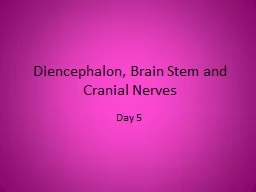

Day 5 Diencephalon Located between the cerebral hemispheres and above midbrain Composed largely of gray matter Surrounds 3 rd ventricle Includes Thalamus Hypothalamus Optic tracts Optic ID: 913066
Download Presentation The PPT/PDF document "Diencephalon, Brain Stem and Cranial Ner..." is the property of its rightful owner. Permission is granted to download and print the materials on this web site for personal, non-commercial use only, and to display it on your personal computer provided you do not modify the materials and that you retain all copyright notices contained in the materials. By downloading content from our website, you accept the terms of this agreement.
Slide1
Diencephalon, Brain Stem and Cranial Nerves
Day 5
Slide2Diencephalon
Located between the cerebral hemispheres and above midbrain
Composed largely of gray matter
Surrounds 3rd ventricleIncludes:ThalamusHypothalamusOptic tractsOptic chiasmaInfundibulumPosterior pituitary glandMammillary bodiesPineal gland
Slide3Parts to Diencephalon
Optic tracts/optic
chiasma
Formed by optic nerve fibers crossing over each otherInfundibulumBehind optic chiasma, attachment for pituitary glandPosterior pituitary glandHangs from floor of hypothalamusMammillary BodiesTwo rounded structures behind infundibulumPineal glandCone shaped structure attached to upper portion of diencephalon
Slide4Thalamus
Bulge into 3
rd
ventricleCentral relay station for all sensory impulses except smell (ascending fibers)Channels impulses to appropriate regions of cortex for interpretationCan communicate with cerebral cortex by means of descending fibers
Slide5Hypothalamus
Located below thalamus and forms floor of 3
rd
ventricleMaintains homeostasis and links endocrine to nervous systemRegulates:Heart rate and arterial BPBody Temp.H2O and electrolyte balanceControl of hunger and body weightControl movements and glandular secretions of stomach and intestinesProduction of neurosecretory substances and stimulation of pituitary gland to secrete hormonesSleep and wakefulness
Slide6Other functions of Diencephalon
Limbic System
Comprised of parts of: cerebral cortex, frontal and temporal lobes, hypothalamus, thalamus basal ganglia and other deep masses called nuclei
Controls emotional experiences and expressionsCan modify the way a person actsFear, anger, pleasure, and sorrowGuides persons behavior towards a likely increase in survival.
Slide7Brain
Stem
Bundle of nervous tissue that connects cerebrum to spinal cord.
Consists of three partsMidbrainPonsMedulla Oblongata
Slide8Midbrain
Located at the top between diencephalon and
pons
Contain corticospinal tracts which are the main motor pathways between cerebrum and lower parts of nervous systemContains several masses of gray matter that serve as reflex centers.
Slide9Pons
Rounded bulge on underside of brain stem
Dorsal side relays impulses to and from M.O and cerebrum.
Ventral side transmits impulses to cerebrum and cerebellum.Also relays sensory impulses from PNS to higher brain centers
Slide10Medulla Oblongata
End of brain stem
All ascending and descending nerve fibers pass through MO
Controls vital visceral activitesCardiac centerAlters heart rateVasomotor CenterConstricting and dilating of blood vesselsRespiratory CenterRegulate rate, rhythm, and depth of breathingAlso responsible for coughing, sneezing, swallowing and vomiting.
Slide11Reticular Formation
Found throughout the brain stem
Network of nerve fibers
Responsible for taking sensory impulses and activating cerebral cortex into a state of wakefulnessDecreased activity in reticular formation is known as sleep.Comatose state:Point at which the reticular formation is injured and cannot be aroused even with strong stimulation.
Slide12Cerebellum
Large mass of tissue located below occipital bone.
Divided into two hemispheres
Surrounded by cerebral cortexCommunicates with CNS by three pairs of nerve tractsCerebellar peduncles
Slide13Cellebellar
Peduncles
Inferior
Brings sensory information concerning position of limbs, joints, and other body partsMiddleTransmits signals from the cerebral cortex to the cerebrellum concerning desired positions of these parts. After interpretation/analysis, sends pulses on to 3rd pairSuperiorIncorporated into motor impulses that get sent down brainstem to move body in desired way.
Slide14Cerebellum
Reflex center for integrating sensory information concerning position of body parts and coordination of skeletal muscle movements
Maintains posture
Damage/InjuryTremorsInaccurate movements of voluntary musclesLoss of muscle toneReeling walkLoss of equilibrium
Slide15Review
What are the major functions of the thalamus? The hypothalamus?
How may the limbic system influence behavior?
List the structures of the brain stem.What vital reflex centers are located in the brain stem?What is the function of the reticular formation?Where is the cerebellum located?What are the major functions of the cerebellum?